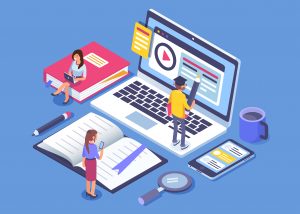How E-learning helps Achieving Academic Objectives?

E- Learning can refer to any kind of learning done through a computer or another device such as an I-pad and is made possible through the internet. Primarily, E-learning serves the purpose of making it possible for the people to be able to learn for purposes of professional development or enhancement of skills at a personal level without having to physically attend an institution of higher learning. It has the power to be able to accommodate all learning styles.
It has revolutionized how education is imparted at a larger scale and proven to be a great encouragement for students from all backgrounds around the world. It has also empowered the time bound students to seek online solutions to achieve academic success such as essay writing service being offered by many websites online.
Here we explore how it is helping meet academic objectives and proving to be mutually beneficial for both students and teachers in some of the following ways:
1- Removing the Barriers:
The Digital learning methods make the access of knowledge open for all. People facing any kind of bottlenecks be it financial, geographical barriers or even physical impediments. This makes the achievement of academic objectives easier as people involved in the process don’t have to deal with these problems anymore. It brings knowledge updated in real time, readily accessible all over the world.
2- Monitoring/Assessment:
The features coming with Learning Development System’s enable the quick analysis of the progress being made by the students at both individual and collective level. It enables the educators to detect any weaknesses of the students and determine what their needs are. This is made possible due to the readily available assessment information.
3- Content Creation Capabilities:
These systems have evolved into Learning Content Management Systems. With these tools, teachers are able to create their own customized courses entailing questionnaires, surveys, quizzes and many other options such as issuance of certificates upon course completion, to make learning interactive as well as greater engagement of students. Thus, the chances of students being able to better learn the intended material are increased.
4- Collaborative Solutions:
They systems put forth a diverse set of communication tools and resources for the teachers so that they can keep their students engaged and develop a sense of belonging to the digital classroom. For instance FAQs – Frequently Asked Question’s section can be there for the students or community discussion for them to share knowledge pertaining to the course.
5- Unhindered Learning:
Given the adaptable nature of Learning Management Systems, learning never stops. The platforms can be accessed via tablets or mobiles too, to access materials and keep learning. The system automatically displays the best version based upon the device’s interface and even makes many features available offline, making sure that learning never stops. The student keeps learning and moving towards his academic objectives, no matter what and wherever he is.
6- Social Learning:
Modern online learning solutions also make social learning possible. The educators get a better chance to interact freely with their students through the integration of social media, leading towards the personalization of the learning.
7- Availability of Teacher:
As opposed to a traditional or conventional classroom, where a large number of students have to compete with each other to gain the teacher’s attention and those who fail to do so lag behind, in a digital classroom, the teacher is available for individual attention for each of the students through Private messaging chats or otherwise. A teacher can always be reached out to, for facilitation in achieving the course outcomes.
8- Up to date Content:
These systems provide the instructors of a course with the unique ability to keep the course material completely up to date with the relevant information and in line with any changes that may have occurred in the relevant field. This can lead to the greater achievement of the academic objectives since students are better prepared at answering questions that gauge their knowledge pertaining to the subject and whether it’s relevant as per the latest trends.
9- Advanced Reporting System:
Most platforms incorporate advanced reporting systems within their interface. These systems make it possible for the instructors to track down the progress being made by the students. They can do so through the download of detailed reports elucidating the progress of each of the individuals and the groups as whole. This enables the instructor to better evaluate and analyze the student’s progress against the learning outcomes of the course being taught.
10- Bilingual Features:
Most platforms come with multi language features which means that both the students and teachers can chose the language they are most comfortable with. This removes the language barrier for most students if they are unable to understand the language the course is being offered in, or if they speak a different language than the instructor.
All in all, it can be said with certainty that E-learning can help achieve the academic objectives a great deal when used efficiently, whether the course is being offered online primarily or-if the digital learning is only being used to supplement the classroom learning and make it effective.










As online learning provides a greater degree of versatility, it can be less stressful to operate besides other responsibilities. Moreover, there is less pressure to engage the students. I’m learning about Content Writing Pakistan (LINK REMOVED BY EDITOR) because I’m working as a content writer so it can help me to get more knowledge about my work.